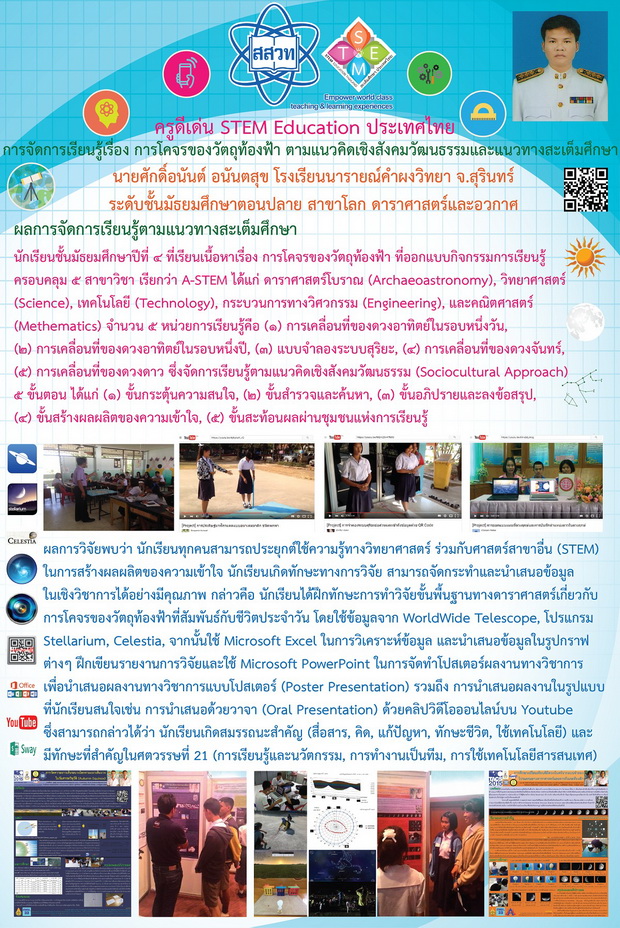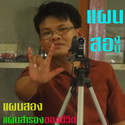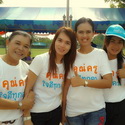 ชื่อผลงาน : ผลการจัดการเรียนรู้เรื่อง การโคจรของวัตถุท้องฟ้า ตามแนวคิดเชิงสังคมวัฒนธรรมและแนวทางสะเต็มศึกษา
ชื่อผลงาน : ผลการจัดการเรียนรู้เรื่อง การโคจรของวัตถุท้องฟ้า ตามแนวคิดเชิงสังคมวัฒนธรรมและแนวทางสะเต็มศึกษา
เจ้าของผลงาน : นายศักดิ์อนันต์ อนันตสุข ครูโรงเรียนนารายณ์คำผงวิทยา จังหวัดสุรินทร์
รางวัล : ครูดีเด่น STEM Education ประเทศไทย (Thailand STEM Education Teacher Award) ระดับประเทศ ระดับมัธยมศึกษาตอนปลาย สาขาโลก ดาราศาสตร์และอวกาศ โดยสถาบันส่งเสริมการสอนวิทยาศาสตร์และเทคโนโลยี เมื่อวันที่ 16 ธันวาคม 2558
บทคัดย่อผลงาน :
การวิจัยครั้งนี้ มีวัตถุประสงค์ เพื่อศึกษาความสามารถในการสร้างผลผลิตของความเข้าใจตามแนวทางสะเต็มศึกษาของนักเรียนชั้นมัธยมศึกษาปีที่ 4 ที่เรียนเนื้อหาเรื่อง การโคจรของวัตถุท้องฟ้า ที่ออกแบบกิจกรรมการเรียนรู้ครอบคลุม 5 สาขาวิชา ที่เรียกว่า “A-STEM” ได้แก่ ดาราศาสตร์โบราณ (A), วิทยาศาสตร์ (S), เทคโนโลยี (T), กระบวนการวิศวกรรมศาสตร์ (E) และคณิตศาสตร์ (M) จำนวน 5 หน่วยการเรียนรู้ คือ (1) การเคลื่อนที่ของดวงอาทิตย์ในรอบ 1 วัน, (2) การเคลื่อนที่ของดวงอาทิตย์ในรอบ 1 ปี, (3) แบบจำลองระบบสุริยะ, (4) การเคลื่อนที่ของดวงจันทร์, (5) การเคลื่อนที่ของดวงดาว ซึ่งจัดการเรียนรู้ตามแนวคิดเชิงสังคมวัฒนธรรม (Socio-cultural Approach) 5 ขั้นตอน ได้แก่ (1) ขั้นกระตุ้นความสนใจ (2) ขั้นสำรวจและค้นหา (3) ขั้นอภิปรายและลงข้อสรุป (4) ขั้นสร้างผลผลิตของความเข้าใจ (5) ขั้นสะท้อนผลผ่านชุมชนแห่งการเรียนรู้
ผลการวิจัยพบว่า นักเรียนทุกคนสามารถประยุกต์ใช้ความรู้ทางวิทยาศาสตร์ร่วมกับศาสตร์สาขาอื่น เช่น ดาราศาสตร์โบราณ คณิตศาสตร์ เทคโนโลยี และกระบวนการทางวิศวกรรม ในการสร้างผลผลิตของความเข้าใจ นักเรียนเกิดทักษะทางการวิจัย สามารถจัดกระทำและนำเสนอข้อมูลในเชิงวิชาการอย่างมีคุณภาพ กล่าวคือ นักเรียนได้เรียนรู้และฝึกการทำวิจัยขั้นพื้นฐานทางดาราศาสตร์เกี่ยวกับการโคจรของวัตถุท้องฟ้าที่สัมพันธ์กับชีวิตประจำวัน โดยใช้ข้อมูลจากโปรแกรม WorldWide Telescope, โปรแกรม Stellarium, โปรแกรม Celestia, จากนั้นใช้โปรแกรม Microsoft Excel ในการวิเคราะห์ข้อมูลและนำเสนอข้อมูลในรูปกราฟต่างๆ ฝึกเขียนรายงานการวิจัยและใช้ Microsoft PowerPoint ในการจัดทำโปสเตอร์ผลงานทางวิชาการ เพื่อนำเสนอผลการทำวิจัยด้วยรูปแบบโปสเตอร์ (Poster presentation) รวมถึงการนำเสนอผลงานในรูปแบบอื่นๆ ที่นักเรียนสนใจ เช่น คลิปวิดีโอ นอกจากนี้ นักเรียนยังเกิดสมรรถนะสำคัญ (สื่อสาร, คิด, แก้ปัญหา, ทักษะชีวิต, การใช้เทคโนโลยี) และมีทักษะที่สำคัญในศตวรรษที่ 21 (การเรียนรู้และนวัตกรรม, การทำงาน, ICT)
คำสำคัญ : การโคจรของวัตถุท้องฟ้า, แนวคิดเชิงสังคมวัฒนธรรม, สะเต็มศึกษา
บทคัดย่อภาษาอังกฤษ
Title : Effect of teaching and learning about Celestial motion through a sociocultural approach and STEM Education
Abstract :
This research aimed to study grade 10 students’ abilities of the create production understanding base on the STEM Education. The participants were learning five A-STEM activities in the celestial motion unit that including (1) the motion of the Sun (in the day), (2) the motion of the Sun (in the year), (3) the motion of the Moon, (4) The Solar system model, and (5) the motion of the stars. The framework of teaching celestial motion through the Sociocultural approach consists of five stages; (1) Engagement, (2) Investigation, (3) Discussion and conclusion, (4) Create production understanding, and (5) Learning community reflection.
The findings revealed that all student’s group can integrate knowledge from A-STEM (A; Archaeoastronomy, S; Science, T; Technology, E; Engineering, and M; Mathematics) to create their production understanding. In addition, students have research skills and also presented their projects on academic quality. They practice the basic astronomy research about the celestial motion within their context that using data from astronomical program such as WorldWide Telescope, Stellarium, Celestia. Then, student using the Microsoft Excel analyzed data and created result graph. They also using the Microsoft PowerPoint to created academic poster for poster presentation and video clips as oral presentation. It can mention that students have five student’s performances (communicate, thinking, solve problem, life skill, using technology) and 21st century learning skills (Learning and Innovation, Life and career, Information media and technology).
Keyword : celestial motion, Socio-cultural Approach, STEM Education


